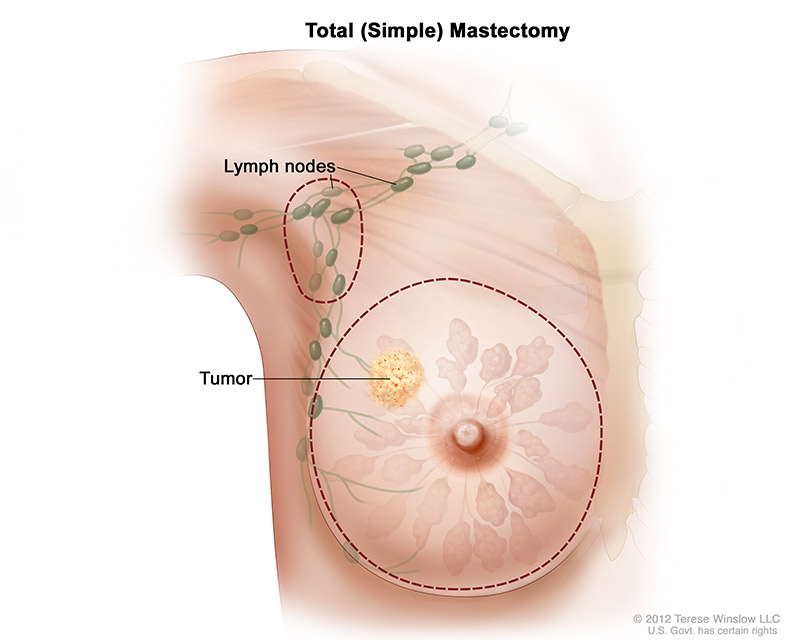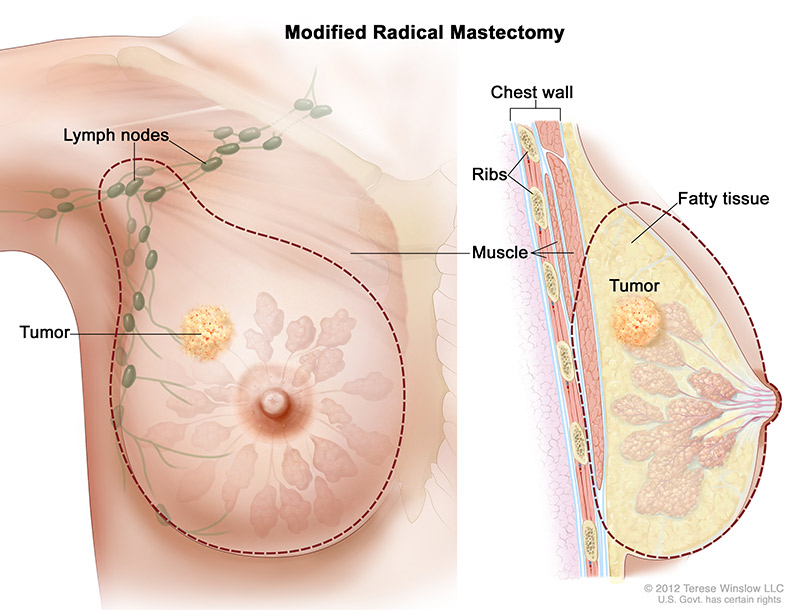Breast Removal Surgeries
There are many different types of mastectomies, depending on how much tissue is removed and how the procedure is performed.
A simple mastectomy removes all of the visible breast tissue and as much skin as needed to make the chest as flat as possible. This is what is done for women who want to have a flat chest after surgery (no reconstruction).

A simple mastectomy can be done in conjunction with a sentinel lymph node biopsy or an axillary lymph node dissection (in which case it is called a modified radical mastectomy) if either of these procedures are needed.

Women who are smokers have an increased risk of complications with any form of mastectomy or reconstruction, however a simple mastectomy has the lowest risk compared to the other types.
Nipple-sparing mastectomy keeps the nipple and areola intact along with the breast skin. There are many different incisions used to do this surgery. Your breast surgeon and plastic surgeon will discuss with you which incision option is best for you given your cancer location and breast shape/size.
In all cases, all visible breast tissue is removed. No matter what incision is used, tissue beneath the nipple and areola are checked for cancer. If cancer is detected, the nipple is removed, converting the procedure to a skin-sparing mastectomy.
With either surgery, breasts are then reconstructed with an implant or tissue taken from another area of the body.
Candidates for nipple-sparing mastectomy include:
- Women whose tumor does not involve the nipple or tissue under the areola
- Women whose tumors are surrounded by a clear margin of cancer-free tissue and not involving the skin
Poor candidates for nipple-sparing mastectomy include:
- Women who have been diagnosed with inflammatory breast cancer or advanced breast cancer with skin involvement
- Women who smoke
- Women with large or ptotic (sagging) breasts
- Women who want smaller reconstructed breasts than their original size
Reference: https://www.breastcancer.org/treatment/surgery/mastectomy/nipple-sparing
Skin-sparing mastectomy is a technique that preserves as much of the breast skin as possible for reconstruction purposes. Skin-sparing mastectomy can be performed as a total mastectomy (just the breast tissue), breast tissue plus sentinel lymph node biopsy, or as a modified radical mastectomy (breast tissue plus axillary lymph node dissection) to provide the skin needed for immediate reconstruction.
During skin-sparing mastectomy, the surgeon removes only the skin of the nipple and areola. Then the surgeon removes the breast tissue through the small opening that is created. The remaining pouch of skin provides the best shape and form to accommodate an implant or a reconstruction using your own tissue. Many women choose this type of mastectomy in order to get the most realistic and pleasing results from breast reconstruction.
Most women are eligible for skin-sparing mastectomies. However, there are some exceptions:
- A skin-sparing mastectomy is not usually performed if you’ve decided that you will not have immediate breast reconstruction.
- A skin-sparing mastectomy is not safe if there is a possibility that tumor cells are close to the skin. If there's any question that the tumor may involve the skin, such as in inflammatory breast cancer, then skin-sparing mastectomy is not an option.
Women who are smokers have an increased risk of complications with any form of mastectomy or reconstruction.
Reference: https://www.breastcancer.org/treatment/surgery/mastectomy/skinsparing
Do you need to remove both breasts?
The answer to this question is based on where the cancer has been found. For women who have a BRCA gene mutation, you can also discuss preventative mastectomy with your breast surgeon. Learn more about genetic testing for the BRCA gene mutation.
![]()
